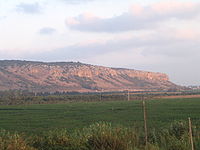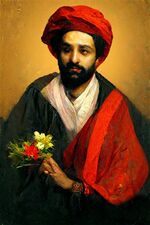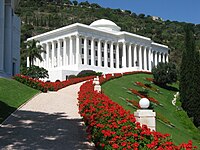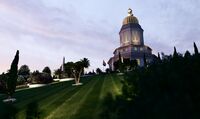Mount Ilias
This article is incomplete because it is pending further input from participants, or it is a work-in-progress by one author. Please comment on this article's talk page to share your input, comments and questions. Note: To contribute to this article, you may need to seek help from the author(s) of this page. |
| Mount Ilias | |
|---|---|
| Bukit Ilias / Berg Ilias | |
 Mount Ilias at sunset | |
| Highest point | |
| Elevation | 539.3 m (1,769 ft) |
| Naming | |
| Native name | Bukit Ilias |
| Geography | |
| Location | Mount Ilias Commune |
| Part of a series on | |||||
| Esoteric Shi'ism | |||||
|---|---|---|---|---|---|
 | |||||
| The Seven Figures | |||||
|
|||||
| The Seven Principles | |||||
|
|||||
| Beliefs and practices | |||||
| Place of worship | |||||
|
|||||
| Holy days | |||||
|
|||||
| Texts | |||||
| Governance | |||||
Mount Ilias (Indonesian: Bukit Ilias; Dutch: Berg Ilias; Riysan: Jabal Ilyas) is a mountain on the island of Java, Hindia Belanda, which hosts the central administrative buildings of the Shia Convocation, the governing body of Esoteric Shi'ism subordinate to the Auxiliary Imamate, as well as several Esoteric Shia holy sites, terraced gardens and a natural reserve. On the crest of Mount Ilias are some of the most important buildings and structures of the Shia Convocation, including the Grand House of Remembrance, the Irfan Institution, the Batini Archives and the Shrines of Esoteric Shia figures. The summit and upper slopes of the mountain are completely landscaped and form part of the extensive terraced gardens which fades into a natural reserve covering the rest of the mountain. Due to the presence of Esoteric Shia holy sites, Mount Ilias is considered by Esoteric Shias as one of the Sacred Thresholds (Riysan: Al-Atabát al-Muqaddas, Dutch: Heilige drempels, Indonesian: Ambang batas suci), thus Esoteric Shias are expected to attain ritual purity before approaching the sacred sites on the mountain.
Mount Ilias is the only privately-owned mountain in Hindia Belanda, a unique situation which resulted from the signing of the 1822 Treaty of Bukit Ilias between the Auxiliary Imamate and the then colonial government. The treaty recognised the Auxiliary Imamate as a self-governing entity and afforded it with autonomous rights independent from the colonial government. The Auxiliary Imamate lost its self-governing status over Mount Ilias upon the independence of Hindia Belanda in 1929 but the mountain has remained in the possession of the Auxiliary Imamate ever since, following negotiations on the eve of Hindia Belandan independence. The territory which covers the mountain and its surrounding foothills belongs to the Auxiliary Imamate, but there are publicly-funded police and fire stations located throughout the area.
Access to Mount Ilias is open to the general public, although road access to the summit is limited to official vehicles of the Shia Convocation. Visitors can reach the summit in 8 minutes by riding a funicular from the base of Mount Ilias free of charge. It is possible although not advisable to climb the mountain by foot.
History
Foothills
Visitor centre
Pilgrims' Entrance
The Pilgrims’ Entrance is the point of entry for pilgrimages to Mount Ilias. Only Esoteric Shias who have come to Mount Ilias for the sole purpose of making pilgrimage to the holy shrines on the mountain may enter through the Pilgrims’ Entrance. This entrance is serviced by funicular which transports pilgrims directly to the eastern end of the summit, where the Shrine of the Four Wandering Deputies and the Shrine of Lady Ruhiya are located.
A prayer is recited by pilgrims after entering the Pilgrims’ Entrance but before riding the funicular to the summit:
"O Lord my God! I have abased myself and wronged the temple of my spirit with my shortcomings, yet I come, lowly and tearful, standing at Thy Sacred Threshold, to seek refuge at Thy holy door. I testify that I am not worthy to approach the lofty stations of those whom Thou lovest. Great are the tribulations which have showered my soul and even greater are my errors which I commit knowingly and unknowingly, but Thou art the Most Compassionate, the Companion of the beset and the Forgiver of the most grievous of wrongs. Therefore have pity upon this lowly self, O Lord, and help me purify my hearing, my sight and my speech that I may remember Thee with every breath I take. Thou art the King, the All-Knowing. No God is there but Thee, the Help in Peril, the Most Merciful, the Most Manifest of the manifest and the Most Hidden of the hidden."
Administrative buildings of the Auxiliary Imamate and the Shia Convocation
Seat of the Auxiliary Imamate

The Seat of the Auxiliary Imamate is a building at the western end of the summit of Mount Ilias where the Auxiliary Imam attends to his daily business. The eclectic four-storey building features a rotunda where an always vacant throne placed on a dais, symbolising the authority of the Hidden Imam, is situated. On the second floor, there is a prayer hall for the private perusal of the Auxiliary Imam, Custodians of Mount Ilias and elected National Councillors for Hindia Belanda and Continental Councillors for Lorecia. A series of rooms on the third floor is occupied by the Shia Convocation's Department for the Maintenance of Sacred Structures. The building is crowned by a dome, has eight sides and surrounded by a landscape garden with reflective pools. Under the building is a vast network of climate-controlled archival rooms for the safekeeping of important documents and objects.
Built in 1912 with the help of the colonial government, the Seat of the Auxiliary Imamate was envisioned by Siyyid Irfan IV, the 31st Auxiliary Imam, as the administrative centre of the Shia Convocation to alleviate the cramped conditions of the Grand House of Remembrance on whose upper levels all departments and bodies of the Shia Convocation were previously headquartered. By 1919, it became apparent that the new Seat of the Auxiliary Imamate could not even accommodate the growing number of departments and institutions of the Shia Convocation and it was then decided that additional buildings were to be constructed. All departments and institutions of the Shia Convocation that were previously headquartered at the Seat of the Auxiliary Imamate, except for the Department for the Maintenance of Sacred Structures, have moved into other buildings on Mount Ilias since 1949.
The Seat of the Auxiliary Imamate is where the Auxiliary Imam holds audience with Hindia Belandan and visiting foreign dignitaries as well as address the Esoteric Shia faithful everyday before sunset from the upper balcony. The building is closed to visitors and pilgrims, with the exception of open house days at the end of August and October.
National Council for Hindia Belanda
The National Council for Hindia Belanda, the elected 12-member assembly subservient to the Auxiliary Imamate which oversees the affairs of Esoteric Shias in Hindia Belanda, is headquartered at the Jalilih Building. Construction began in 1920 and completed in 1923. The four-storey building is built in the Neoclassical style as a homage to the short but architecturally influential Exponential era in Hindia Belanda, during which many buildings were constructed by the Auxiliary Imamate throughout its territory bearing clear influence of Exponential architecture.
The building comprises a series of rooms and chambers for the daily running of the National Council for Hindia Belanda. Due to the uneven terrain on which the building stands, the lowest floor remains under the main entrance which is on the second floor. The building also houses other offices of the Shia Convocation, most notably the Department for the Protection of the Faithful. There is an annex behind the building which serves as the official residence of the 12 National Councillors for Hindia Belanda and their staff.
A large Bayt al-Adhkar (House of Remembrance) built in the Exponential style during Exponential rule originally stood on the current location of the National Council for Hindia Belanda, but in 1799 was destroyed by a mob during public unrest surrounding the bankruptcy of the Noordenstaater Trading Company and its eventual takeover by the Noordenstaater crown. The old Bayt al-Adhkar was never rebuilt at its original location and was instead constructed on the southern slope of Mount Ilias near the Audience Garden. A series of expansions of the rebuilt Bayt al-Adhkar started in 1812 which culminated in 1953 with the addition of two additional tiers and a dome. The rebuilt Bayt al-Adhkar was rededicated as the Grand House of Remembrance in 1953 and now serves as the primary place of worship on Mount Ilias.
Continental Council for Lorecia
The Continental Council for Lorecia, the 12-member assembly elected from amongst Esoteric Shias of Lorecian nationalities, is headquartered at the Masra'ih Building beside the building of the National Council for Hindia Belanda. Built in 1930, a year after Hindia Belandan independence, the Masra'ih Building features neoclassical architectural elements. There are passages from the Book of Fatima engraved in various Lorecian languages on the rear portico of the building. The two porticos are adorned by coffered ceilings with names of the Fourteen Infallibles written on each of its recessed panels.
The two-storey building primarily serves as the meeting place of Continental Councillors for Lorecia, whilst an annex housing their residence is connected to the building by a subterranean passageway. The Masra'ih Building was constructed with the financial help of an anonymous "wealthy Noordenstaater-born Hindia Belandan" and was designed to mirror the neoclassical style of the other adjacent buildings.
The Masra'ih Building is closed to visitors.
Department for Charities and Welfare
The Shia Convocation's Department for Charities and Welfare, Hindia Belanda's largest humanitarian organisation, is headquartered at the Fatimih Building next to the building of the National Council for Hindia Belanda. Like the other adjacent buildings, the Fatimih Building is built in the neoclassical style. The Fatimih Building recedes into the sloped terrain and most of its rooms are located under the terrain. Under the building is a series of subterranean levels which hosts the offices of the Department for Charities and Welfare as well as the general archives of the Shia Convocation.
The Fatimih Building was built in 1927. It originally served as the offices of the Councillors for the Lands Across the Sea, who represent Esoteric Shias residing outside Hindia Belanda, Maqtajer and the continents of Sythith and of Lorecia.
The Custodianship of Mount Ilias
Department of the Sacred Thresholds
Irfan Institution
Council for the Lands across the Sea
The Council for the Lands across the Sea is the 4-member assembly elected from amongst Esoteric Shias of nationalities other than Lorecian, Hindia Belandan or Maqtajeri, tasked with overseeing the affairs of Esoteric Shias living outside those territories. It is headquartered at the
Sacred sites
Grand House of Remembrance
The Grand House of Remembrance is the primary place of worship on Mount Ilias.
Shrine of the Four Wandering Deputies

The Shrine of the Four Wandering Deputies is a sacred edifice where the remains of the Four Wandering Deputies, who delivered the news of the commencement of the Major Occultation to Esoteric Shias in Astyria, are interred. Completed in 1189, the Shrine is one of the oldest buildings on Mount Ilias still standing to this day. The original structure as constructed in the late 12th century is now completely within the current structure, which was expanded many times by successive Auxiliary Imams. The Shrine is located on the 19th terrace of the terraced gardens and visitors and pilgrims to the Shrine usually start their approach to the Shrine by climbing from the 15th terrace of the terraced gardens. The Shrine is one of several structures on Mount Ilias where one is expected to be in a state of ritual purity in order to approach it and its immediate environs. Therefore, pilgrims and visitors alike are told to perform the minor ablution at an ablution point available on the 15th terrace or the 12th terrace of the terraced gardens.
The Shrine comprises six chambers, one of which situated at the centre of the edifice contains the graves of the Four Wandering Deputies. The interior of the Shrine is open to the general public. Once inside, visitors are not allowed to talk and must respect the "atmosphere of prayer and reverence". The Shrine is flanked by leafy gardens with several manicured grass fields where pilgrims may sit and recite the Prayer of Visitation towards the direction of the Shrine.
Several lifts for disabled persons with stops at every terrace are available.
Shrine of Lady Ruhiya
The Shrine of Lady Ruhiya is a sacred edifice under which is buried the remains of Lady Ruhiya, an Esoteric Shia saint who was martyred in 1387. The Shrine is a rectangular structure adorned with multicoloured calligraphic and geometric ornaments dating from the time of the 17th Auxiliary Imam, Siyyid Jalal al-Din Hassan, who also oversaw the expansion of the Grand House of Remembrance and the planting of the terraced gardens. Inside the Shrine are four rooms encircling a central chamber where the grave of Lady Ruhiya is located. The grave is enclosed by a protective structure decorated with ornate glass and mirror works which create a shimmering effect and visitors may peek into the structure to see the grave through small openings.
The rooms surrounding the central chamber are filled with rugs and seating where pilgrims may comfortably recite the Prayer of Visitation.
Shrine of Siyyid Mahdi
The Shrine of Saint Siyyid Mahdi is located in the western part of the summit, within a landscape garden near the Seat of the Auxiliary Imamate. The Shrine is where the remains of Saint Siyyid Mahdi, the 3rd Auxiliary Imam, are interred. The tomb, made of marble, is sheltered by a domed monopteros with corinthian columns. A lantern is suspended from the inner part of the dome. The Shrine is enclosed by a tall hedge with an ornate central gate that is closed to visitors and pilgrims who can only see the tomb from outside the hedge. A pathway encircles the hedge enclosure and it is the practice that pilgrims circumambulate the Shrine by walking on the pathway for 12 times.
The landscape garden where the Shrine is located is filled with trees and wildflowers, whilst a lemon grove and an orangerie are situated east of the Shrine.






